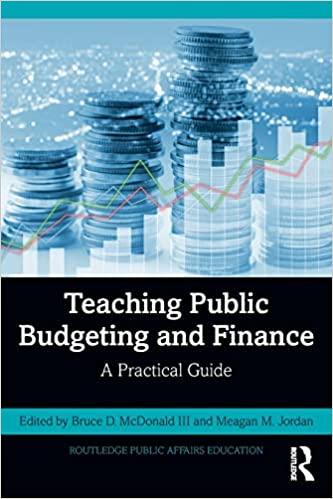1. Which of these is a tangible factor? a. History b. Reputation c. Staff d. None of the above 2. Short-term plans primarily include: a. Production b. Financing C. Control d. All of the above budget. 3. The incremental-decremental approach starts with a(n). a. New b. Outdated c. Industry standard d. Existing to a program budget. 4. A performance budget adds a. Subcategories b. Performance measures c. Overhead d. Cost of capital and a 5. An operating budget is comprised of a a. Statistics budget; expense budget b. Revenue budget; expense budget C. Cost report; Expense report d. Revenue budget; statistics budget 1. Present value (PV) refers to: a. Worth in future of an amount invested today b. Worth today of future payment c. Worth in the future of a series of payments over time d. None of the above 2. Future Value Table is used: a. As an alternative to calculating the future vale using the formula b. An alternative to calculating the present value c. An alternative to calculating the time value of money d. B&C 3. Present value of an annuity refers to: a. What series of equal payment in the future is worth today taking into account time value of money b. A factor that when multiplied by a stream of equal payments equals present value c. What an equal series of payments will be worth at some future date using compound interest d. None of the Above 4. Future value is determined using: a. Worth of a dollar today b. Calculations only on the original principle C. A compound interest method d. Using a simple interest method 1. A fund in which monies are set aside each year to ensure that a bond can be liquidated at maturity is a? a. Sinking fund b. Swimming fund C Bond fund d. Term fund 2. An asset with clear value that is pledged against a loan to reduce risk to the lender is: a. Colloidal b. Bonds C. Collateral d. Trustee 3. A secondary market deals with buying and selling bonds that have already been a. Called b. Forfeit c. Issued d. Exempted 4. According to Fitch and S&P's bond ratings, which rating is highest? a. AAAA b. Aa C. AAA d. BBB of its economic life. 5. In a capital lease the lessor aims to lease the asset for a. None b. Virtually all c. Virtually half d. An insignificant amount 5. Annuity due refers to: a. A series of equal annuity payments made or received at the beginning of each period b. A series of equal payments in the future is worth today c. Factors that show the value today of equal flows at the end of each future period d. An equal series of payments worth at some future date 1. The component(s) of a capital investment decision are: a. Determining if the investment is worth while b. Costs of investing c. Determining how to finance the investment d. Both a &c 2. The strength(s) of the NPV analysis are: a. Answers in dollars, not years b. Accounts for all cash flows in the project c. Discounts at the cost of capital d. All of the above 3. If the IRR is equal to the required rate of return the project should be: a. Accepted b. Rejected c. Handled indifferently d. Reinvented 4. Sunk costs are: a. Recoverable b. Not recoverable c. Indicators of future gains d. Management's poor decisions investment. 5. The payback method measures how long it will take to recover a. Total b. Past c. Initial d. Non-financial










